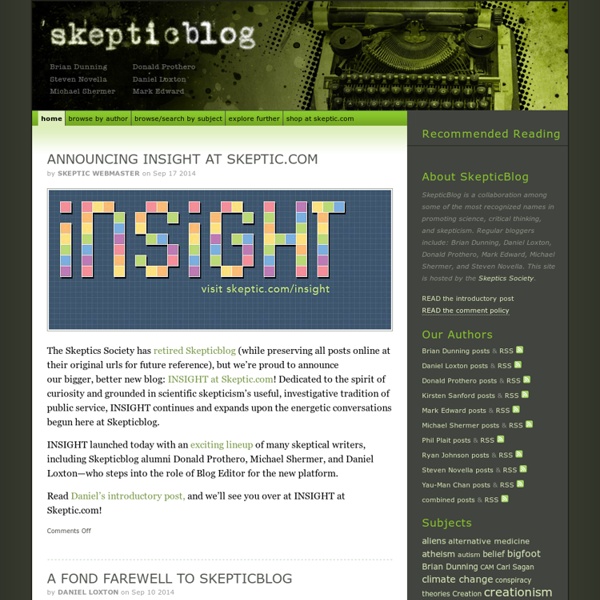Biology of Religion
03. March 2012, 11:06 The online-magazine Evolution: This View of Life did get a new (and, if I might say, awesome) look. For example, the recommendation of John Jacob Lyons, who is a regular commentator here, about presenting the number of comments to each post has been fulfilled.
Bad Astronomy
Well now, this is an interesting discovery: astronomers have found what looks like a "super-Earth" – a planet more massive than Earth but still smaller than a gas giant – orbiting a nearby star at the right distance to have liquid water on it! Given that, it might – might – be Earthlike. This is pretty cool news. We’ve found planets like this before, but not very many!
eSkeptic » Wednesday, July 25th, 2012
A Magician in the ClassroomUsing Magic and Mentalism to Teach Skepticism by Paul Goodin Anyone who teaches can relate to running into the occasional brick wall when trying to convey new ideas. To teach critical thinking and impart a skeptical outlook is difficult in and of itself. But when you are teaching where a majority of the students have strong religious convictions, it can be an even greater challenge.
NeuroTribes
"The Structure of Flame" by autistic artist Jessica Park. Courtesy of Pure Vision Arts: In 2007, the United Nations passed a resolution declaring April 2 World Autism Awareness Day — an annual opportunity for fundraising organizations to bring public attention to a condition considered rare just a decade ago. Now society is coming to understand that the broad spectrum of autism — as it’s currently defined, which will change next year with the publication of the DSM-5 – isn’t rare after all. In fact, “autism is common,” said Thomas Frieden, Director of the U.S. Centers for Disease Control and Prevention, last week in a press conference.
Pharyngula
Probably not. But the New York Times reports: A review of studies has found that the health benefits of infant male circumcision vastly outweigh the risks involved in the procedure. Actually, it doesn’t. Not at all. The paper is all about the frequency of circumcision in the US; this is the only real data in the paper, and notice that a good chunk of it is speculation.
Empirical Zeal
The Christopher Hitchens Web
WhitePagesGoesGreen.org by YellowPagesGoesGreen.org (Yellow Pages Directory Inc.) is a leading online directory allowing users to search an online database and telephone directory for all telephone numbers in the USA. Using the above boxes, simply type in a name and location. Even if you don't have the complete information, the telephone number lookup database can help you find phone numbers.
How To Sell Magic Beans
One of the eternal questions for skeptics is – how can some people be so gullible? We have a standard answer which captures many of the factors: poor understanding of science, lack of an innate sense of probability, all the various mechanisms of self-deception, and the strong desire to believe in certain things. Further, some cons are just slick, and anyone can be fooled by a clever-enough deception. But still, there are some claims that are so astoundingly gullible it’s difficult not to face-palm when confronted by them.
Science News, Articles and Information
Portland State Sociology of Islam & Muslim Societies
The Sociology of Islam and Muslim Societies Newsletter: Winter 2011 Newsletter No. 7 - ISSN:1942-7948 Contents Social and Political Transformations in the Middle East - Umit Kurt and Oguz Alyanak The Political Economy of Turkey’s Response to the Arab Spring - Altay Atli Footsteps of Revolution in the Land of Queen Sheba - Bezen Balamir Coskun Two Sides of the Same Coin; Conflicting Views of Islamism in Pakistan - Jeanette Bailey Egypt and the "Arab Spring": Notes on Facts and Challenges - Moises Garduño García The Arab Spring and the Turkish Model - Alper Y. Dede Will Geopolitics Split Along Sectarian Lines in the Middle East?
Science-Based Medicine
ERS
Charles Darwin and other early evolutionists were fascinated by religious phenomena and how they might be explained from an evolutionary perspective. Nevertheless, evolutionary theory became restricted to the biological sciences and excluded from the study of many human-related subjects for most of the 20th century. Only now is the theory being used to explain all aspects of humanity in addition to the rest of life. The new field of evolutionary religious studies is part of this larger trend. This website provides an introduction to the study of religion from an evolutionary perspective.
Quackwatch
The Association for Religion, Economics and Culture (ASREC)
The Association for the Study of Religion, Economics, and Culture exists to promote interdisciplinary scholarship on religion through conferences, workshops, newsletters, websites, working papers, teaching, and research. ASREC supports all manner of social-scientific methods, but seeks especially to stimulate work based on economic perspectives and the rational choice paradigm. The economic study of religion comprises a variety of subfields, which collectively embrace all aspects of the social-scientific study of religion. It is by no means limited to questions concerning the commercial economy or monetary aspects of religion. Studies of the current and historic role of religion in advancing or impeding economic development, social progress, moral development, scientific and technology advances, and so forth.



